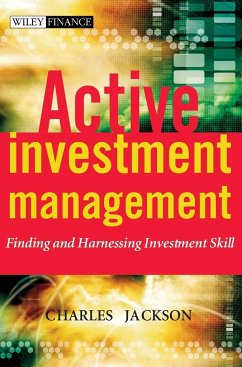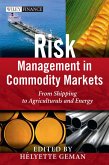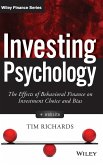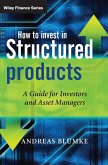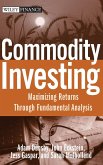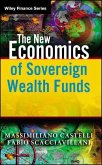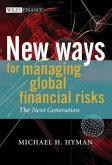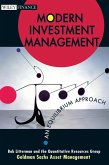- Gebundenes Buch
- Merkliste
- Auf die Merkliste
- Bewerten Bewerten
- Teilen
- Produkt teilen
- Produkterinnerung
- Produkterinnerung
Active Investment Management looks at where active management has come from, where it is today, what problems it faces and where the answers to these questions are leading it. The book addresses the major issues concerning the key groups within the industry.
Charles Jackson's wonderfully readable book will be essential reading for the practitioner and is broken down into five sections covering the whole spectrum of active investment management:
_ asset classes and products _ balancing risk and return _ active product selection _ the nature of skill _ the price of skill
.
Andere Kunden interessierten sich auch für
![Risk Management in Commodity Markets Risk Management in Commodity Markets]() Risk Management in Commodity Markets191,99 €
Risk Management in Commodity Markets191,99 €![Investing Psychology, + Website Investing Psychology, + Website]() Tim RichardsInvesting Psychology, + Website57,99 €
Tim RichardsInvesting Psychology, + Website57,99 €![How to Invest in Structured Products How to Invest in Structured Products]() Andreas BluemkeHow to Invest in Structured Products77,99 €
Andreas BluemkeHow to Invest in Structured Products77,99 €![Commodity Investing Commodity Investing]() Adam DunsbyCommodity Investing51,99 €
Adam DunsbyCommodity Investing51,99 €![The New Economics of Sovereign Wealth Funds The New Economics of Sovereign Wealth Funds]() Massimiliano CastelliThe New Economics of Sovereign Wealth Funds123,99 €
Massimiliano CastelliThe New Economics of Sovereign Wealth Funds123,99 €![New Ways for Managing Global Financial Risks New Ways for Managing Global Financial Risks]() Michael HymanNew Ways for Managing Global Financial Risks105,99 €
Michael HymanNew Ways for Managing Global Financial Risks105,99 €![Modern Investment Management Modern Investment Management]() Robert LittermanModern Investment Management147,99 €
Robert LittermanModern Investment Management147,99 €-
-
-
Active Investment Management looks at where active management has come from, where it is today, what problems it faces and where the answers to these questions are leading it. The book addresses the major issues concerning the key groups within the industry.
Charles Jackson's wonderfully readable book will be essential reading for the practitioner and is broken down into five sections covering the whole spectrum of active investment management:
_ asset classes and products
_ balancing risk and return
_ active product selection
_ the nature of skill
_ the price of skill
.
Hinweis: Dieser Artikel kann nur an eine deutsche Lieferadresse ausgeliefert werden.
Charles Jackson's wonderfully readable book will be essential reading for the practitioner and is broken down into five sections covering the whole spectrum of active investment management:
_ asset classes and products
_ balancing risk and return
_ active product selection
_ the nature of skill
_ the price of skill
.
Hinweis: Dieser Artikel kann nur an eine deutsche Lieferadresse ausgeliefert werden.
Produktdetails
- Produktdetails
- Wiley Finance Series
- Verlag: Wiley & Sons
- 1. Auflage
- Seitenzahl: 210
- Erscheinungstermin: 29. August 2003
- Englisch
- Abmessung: 250mm x 175mm x 17mm
- Gewicht: 562g
- ISBN-13: 9780470858868
- ISBN-10: 0470858869
- Artikelnr.: 13939038
- Herstellerkennzeichnung
- Produktsicherheitsverantwortliche/r
- Europaallee 1
- 36244 Bad Hersfeld
- gpsr@libri.de
- Wiley Finance Series
- Verlag: Wiley & Sons
- 1. Auflage
- Seitenzahl: 210
- Erscheinungstermin: 29. August 2003
- Englisch
- Abmessung: 250mm x 175mm x 17mm
- Gewicht: 562g
- ISBN-13: 9780470858868
- ISBN-10: 0470858869
- Artikelnr.: 13939038
- Herstellerkennzeichnung
- Produktsicherheitsverantwortliche/r
- Europaallee 1
- 36244 Bad Hersfeld
- gpsr@libri.de
CHARLES JACKSON holds an MA from Oxford University and an MBA from Stanford University, where he was a Harkness Fellow. He has 25 years experience in the investment management industry. For 13 years, he was the Head of the Fixed Interest and Currency Division of Mercury Asset Management, for most of the period the largest publicly quoted firm in Europe specialising exclusively in active investment management. He also served on Mercury's Asset Allocation Committee and Chairman's Committee. He was appointed a Vice Chairman of Mercury's Main Board in 1993. He is married, with two children, and lives near Oxford.
Preface xv
Acknowledgements xix
PART I ASSET CLASSES AND PRODUCTS 1
1 Stocks and Shares 3
1.1 Three key preconditions 3
1.1.1 Property rights 3
1.1.2 Limited liability 4
1.1.3 Public financial markets 5
1.2 Market performance 5
1.2.1 Stock indices and performance measurement 6
1.2.2 Twentieth century performance 6
1.3 Active equity management 8
1.3.1 Dividend valuation models 9
1.3.2 Growth stocks 10
1.3.3 Small stocks 10
1.3.4 Sorting active approaches 10
1.4 Institutional investors 11
1.4.1 Life insurance 11
1.4.2 Pension funds 12
1.5 Conclusion 12
Endnotes 13
2 Investment Products 15
2.1 Traditional products 15
2.1.1 Closed-end products 15
2.1.2 Open-ended products 17
2.1.3 Index products 19
2.2 Alternative products 21
2.2.1 Illiquid assets 21
2.2.2 Liquid assets 22
2.2.3 Offshore products 23
2.3 Active overlays 24
2.4 Conclusion 26
Endnotes 26
3 Money 29
3.1 Three defining properties 29
3.1.1 Purchasing power 29
3.1.2 Return 29
3.1.3 Risk-free asset 30
3.2 Early forms of money 31
3.2.1 Gold 31
3.2.2 Deposits 32
3.3 Modern forms of money 33
3.3.1 Retail money funds 33
3.3.2 Institutional money funds 33
3.3.3 Eurodollars 34
3.4 Active cash management 35
3.4.1 Credit risk 35
3.4.2 Maturity risk 36
3.5 Conclusion 36
Endnotes 37
4 Fixed Interest 39
4.1 History 39
4.1.1 UK to 1945 39
4.1.2 USA to 1945 41
4.1.3 From 1945 41
4.1.4 Performance experience 43
4.2 Active maturity management 45
4.2.1 Duration 45
4.2.2 Benchmarks 46
4.2.3 Attribution 46
4.3 Active spread management 46
4.3.1 Mortgages 47
4.3.2 Index-linked bonds 48
4.3.3 Junk bonds and emerging debt 48
4.3.4 Swaps 49
4.4 Market efficiency 50
4.4.1 UK tax arbitrage 50
4.4.2 The US Treasury market 51
4.4.3 Salomon episode 53
4.5 Conclusion 54
Endnotes 54
5 Foreign Assets 57
5.1 History 57
5.1.1 To 1900 57
5.1.2 Foreign bonds from 1900 58
5.1.3 Foreign returns from 1900 59
5.2 Global investors 60
5.2.1 Modern portfolio theory 60
5.2.2 US overseas equity investors 60
5.2.3 US overseas bond investors 61
5.3 Government policy 61
5.3.1 Tax 61
5.3.2 UK exchange control 62
5.4 Active currency management 63
5.4.1 Theory and practice 63
5.4.2 Emerging high-yield strategies 64
5.4.3 European convergence strategies 65
5.4.4 Hedged overseas bonds 66
5.5 Conclusion 68
Endnotes 69
PART II BALANCING RISK AND RETURN 71
6 Measuring Risk 73
6.1 The chance of misfortune 73
6.1.1 Fixed odds 73
6.1.2 Uncertain odds 73
6.1.3 Historical prices 74
6.1.4 Measuring risk from historical prices 75
6.2 A simplifying proposition 75
6.2.1 The chance curve 76
6.2.2 Interval and variance 78
6.2.3 Random walk hypothesis 79
6.3 The case against active management 81
6.3.1 Testing the weak form 82
6.3.2 Testing the semi-strong form 82
6.3.3 Testing the strong form 82
6.4 Guarantees 83
6.5 Conclusion 84
Endnotes 84
7 Investor Objectives 85
7.1 Selected investor instructions 85
7.1.1 UK pensions funds 85
7.1.2 Individual investors 86
7.2 Three essentials 87
7.2.1 Risk-free asset 87
7.2.2 Liabilities 87
7.2.3 Attitude to risk 87
7.3 Trade-off between risk and return 88
7.3.1 Utility theory 88
7.3.2 Varying appetite for risk 89
7.3.3 Constant risk aversion 90
7.3.4 Modelling the risk-return trade-off 90
7.4 Active mandate design 91
7.5 Conclusion 92
Endnotes 92
8 Setting Policy 93
8.1 Policy uniqueness 93
8.1.1 Policy review 93
8.1.2 Policy variation 94
8.2 Liability matching 95
8.2.1 The liability matching condition 95
8.2.2 Historical evidence 96
8.3 Pension fund cash 96
8.4 Active asset allocation 98
8.5 Conclusion 99
Endnotes 99
PART III ACTIVE PRODUCT SELECTION 101
9 Finding Skill 103
9.1 Evidence of skill 104
9.1.1 People 104
9.1.2 Past performance 104
9.2 Measures of skill 105
9.2.1 Confidence 105
9.2.2 The information ratio 106
9.2.3 Active risk 107
9.3 Elusiveness of skill 107
9.3.1 Manager tenure 107
9.3.2 Benchmark ambiguity 108
9.3.3 Experience and age 109
9.4 Advisors and skill 110
9.4.1 Traditional products 110
9.4.2 Hedge funds 111
9.5 Conclusion 112
Endnotes 113
10 Using Style 115
10.1 Active product weights 115
10.1.1 The MPT solution 115
10.1.2 Accuracy 116
10.1.3 The industry solution 116
10.2 Style definition 116
10.2.1 Asset classes 117
10.2.2 Specialised categories 117
10.2.3 Universe medians 117
10.3 Portfolio construction 118
10.3.1 Specialist portfolios 118
10.3.2 Balanced portfolios 119
10.4 Freestanding overlays 119
10.5 Conclusion 121
Endnotes 122
PART IV THE NATURE OF SKILL 123
11 Firms and Professionals 125
11.1 Exceptional talents 125
11.1.1 Benjamin Graham 125
11.1.2 Phillip Fisher 126
11.1.3 Warren Buffett 126
11.2 Public and private information 127
11.2.1 Graham and Fisher 128
11.2.2 Market anomalies 128
11.2.3 Size and value effects 128
11.3 Intuitive and systematic approaches 129
11.3.1 Keynes's metaphor 130
11.3.2 Information and strategy 131
11.3.3 Demonstrating skill 133
11.3.4 Portfolio manager autonomy 133
11.4 Fault lines 134
11.4.1 Institutional processes 134
11.4.2 LTCM 135
11.4.3 MAM fixed interest 136
11.5 Conclusion 137
Endnotes 137
12 Active Overlay Risk 139
12.1 LTCM 139
12.2 Active return distributions 140
12.2.1 Active strategies 140
12.2.2 Trading rules 141
12.3 Different processes 141
12.3.1 Systematic 142
12.3.2 Combined 142
12.3.3 Intuitive 143
12.4 Conclusion 143
Endnotes 144
PART V THE PRICE OF SKILL 145
13 Fees 147
13.1 Types of fee 147
13.1.1 Flat fees 147
13.1.2 Performance fees 148
13.1.3 Transaction charges 150
13.2 Demand and skill 151
13.2.1 The evidence 151
13.2.2 Skill-driven demand 152
13.3 Fee rates and skill 153
13.3.1 Revenue maximising 153
13.3.2 Paying for information 154
13.4 Fee-setting behaviour 155
13.4.1 Traditional products 155
13.4.2 Funds of hedge funds 155
13.4.3 Hedge funds 156
13.5 Conclusion 158
Endnotes 158
14 Pay 159
14.1 Pay and skill 159
14.1.1 Before hedge funds 160
14.1.2 After hedge funds 160
14.1.3 Hedge fund self-investing 162
14.2 Dividing the spoils 162
14.2.1 Prima donnas 163
14.2.2 Threshold skill 163
14.2.3 Position limits 165
14.3 Valuing investment management firms 165
14.3.1 Traditional firms 165
14.3.2 Hedge fund firms 167
14.3.3 Fund of hedge fund firms 167
14.4 Conclusion 168
Endnotes 168
Afterword 169
Technical Appendix 175
A.1 Basic modelling tools 175
A.1.1 Calculus 175
A.1.2 Natural logarithms 176
A.1.3 Normal distribution 177
A.1.4 Central Limit Theorem 177
A.1.5 Higher moments 177
A.2 Investment algebra 178
A.2.1 Time value of money 178
A.2.2 Time versus money-weighted performance measurement 178
A.2.3 Bond prices 179
A.2.4 On and off the run 179
A.2.5 Seventeenth century Dutch annuities 180
A.2.6 Duration 180
A.2.7 Bond attribution 181
A.2.8 Constant growth model 181
A.2.9 Purchasing Power Parity 182
A.2.10 Covered interest arbitrage 182
A.3 Time series analysis 182
A.3.1 Standard approach 182
A.3.2 Confidence interval 183
A.4 Utility theory 184
A.4.1 Certainty equivalent 184
A.4.2 Expected utility 184
A.4.3 Risk adjustment 184
A.4.4 Abnormal distribution 185
A.4.5 Constant relative risk aversion 185
A.5 Mean variance analysis 186
A.5.1 Correlation 186
A.5.2 Matrix algebra 186
A.5.3 Utility maximisation 186
A.5.4 Maximising the mean variance ratio 187
A.5.5 Optimal investment in risky assets 187
A.5.6 Two asset optimisation 187
A.5.7 Liability matching condition 188
A.5.8 Portfolio eligibility 188
A.5.9 Information ratio 189
A.6 Industry economics 190
A.6.1 Demand for freestanding overlays 190
A.6.2 Demand for products with style 191
A.6.3 Revenue maximising fee 192
A.6.4 Combining overlays 193
A.6.5 Information costs 194
A.6.6 Relaxing the independence assumption 194
A.6.7 Self investing 195
A.6.8 Running a hedge fund 195
A.6.9 Hedge fund style 196
A.6.10 Trading limits 196
A.6.11 Trader experience 197
A.6.12 Tenure and investor confidence 197
Endnotes 198
Index 199
Acknowledgements xix
PART I ASSET CLASSES AND PRODUCTS 1
1 Stocks and Shares 3
1.1 Three key preconditions 3
1.1.1 Property rights 3
1.1.2 Limited liability 4
1.1.3 Public financial markets 5
1.2 Market performance 5
1.2.1 Stock indices and performance measurement 6
1.2.2 Twentieth century performance 6
1.3 Active equity management 8
1.3.1 Dividend valuation models 9
1.3.2 Growth stocks 10
1.3.3 Small stocks 10
1.3.4 Sorting active approaches 10
1.4 Institutional investors 11
1.4.1 Life insurance 11
1.4.2 Pension funds 12
1.5 Conclusion 12
Endnotes 13
2 Investment Products 15
2.1 Traditional products 15
2.1.1 Closed-end products 15
2.1.2 Open-ended products 17
2.1.3 Index products 19
2.2 Alternative products 21
2.2.1 Illiquid assets 21
2.2.2 Liquid assets 22
2.2.3 Offshore products 23
2.3 Active overlays 24
2.4 Conclusion 26
Endnotes 26
3 Money 29
3.1 Three defining properties 29
3.1.1 Purchasing power 29
3.1.2 Return 29
3.1.3 Risk-free asset 30
3.2 Early forms of money 31
3.2.1 Gold 31
3.2.2 Deposits 32
3.3 Modern forms of money 33
3.3.1 Retail money funds 33
3.3.2 Institutional money funds 33
3.3.3 Eurodollars 34
3.4 Active cash management 35
3.4.1 Credit risk 35
3.4.2 Maturity risk 36
3.5 Conclusion 36
Endnotes 37
4 Fixed Interest 39
4.1 History 39
4.1.1 UK to 1945 39
4.1.2 USA to 1945 41
4.1.3 From 1945 41
4.1.4 Performance experience 43
4.2 Active maturity management 45
4.2.1 Duration 45
4.2.2 Benchmarks 46
4.2.3 Attribution 46
4.3 Active spread management 46
4.3.1 Mortgages 47
4.3.2 Index-linked bonds 48
4.3.3 Junk bonds and emerging debt 48
4.3.4 Swaps 49
4.4 Market efficiency 50
4.4.1 UK tax arbitrage 50
4.4.2 The US Treasury market 51
4.4.3 Salomon episode 53
4.5 Conclusion 54
Endnotes 54
5 Foreign Assets 57
5.1 History 57
5.1.1 To 1900 57
5.1.2 Foreign bonds from 1900 58
5.1.3 Foreign returns from 1900 59
5.2 Global investors 60
5.2.1 Modern portfolio theory 60
5.2.2 US overseas equity investors 60
5.2.3 US overseas bond investors 61
5.3 Government policy 61
5.3.1 Tax 61
5.3.2 UK exchange control 62
5.4 Active currency management 63
5.4.1 Theory and practice 63
5.4.2 Emerging high-yield strategies 64
5.4.3 European convergence strategies 65
5.4.4 Hedged overseas bonds 66
5.5 Conclusion 68
Endnotes 69
PART II BALANCING RISK AND RETURN 71
6 Measuring Risk 73
6.1 The chance of misfortune 73
6.1.1 Fixed odds 73
6.1.2 Uncertain odds 73
6.1.3 Historical prices 74
6.1.4 Measuring risk from historical prices 75
6.2 A simplifying proposition 75
6.2.1 The chance curve 76
6.2.2 Interval and variance 78
6.2.3 Random walk hypothesis 79
6.3 The case against active management 81
6.3.1 Testing the weak form 82
6.3.2 Testing the semi-strong form 82
6.3.3 Testing the strong form 82
6.4 Guarantees 83
6.5 Conclusion 84
Endnotes 84
7 Investor Objectives 85
7.1 Selected investor instructions 85
7.1.1 UK pensions funds 85
7.1.2 Individual investors 86
7.2 Three essentials 87
7.2.1 Risk-free asset 87
7.2.2 Liabilities 87
7.2.3 Attitude to risk 87
7.3 Trade-off between risk and return 88
7.3.1 Utility theory 88
7.3.2 Varying appetite for risk 89
7.3.3 Constant risk aversion 90
7.3.4 Modelling the risk-return trade-off 90
7.4 Active mandate design 91
7.5 Conclusion 92
Endnotes 92
8 Setting Policy 93
8.1 Policy uniqueness 93
8.1.1 Policy review 93
8.1.2 Policy variation 94
8.2 Liability matching 95
8.2.1 The liability matching condition 95
8.2.2 Historical evidence 96
8.3 Pension fund cash 96
8.4 Active asset allocation 98
8.5 Conclusion 99
Endnotes 99
PART III ACTIVE PRODUCT SELECTION 101
9 Finding Skill 103
9.1 Evidence of skill 104
9.1.1 People 104
9.1.2 Past performance 104
9.2 Measures of skill 105
9.2.1 Confidence 105
9.2.2 The information ratio 106
9.2.3 Active risk 107
9.3 Elusiveness of skill 107
9.3.1 Manager tenure 107
9.3.2 Benchmark ambiguity 108
9.3.3 Experience and age 109
9.4 Advisors and skill 110
9.4.1 Traditional products 110
9.4.2 Hedge funds 111
9.5 Conclusion 112
Endnotes 113
10 Using Style 115
10.1 Active product weights 115
10.1.1 The MPT solution 115
10.1.2 Accuracy 116
10.1.3 The industry solution 116
10.2 Style definition 116
10.2.1 Asset classes 117
10.2.2 Specialised categories 117
10.2.3 Universe medians 117
10.3 Portfolio construction 118
10.3.1 Specialist portfolios 118
10.3.2 Balanced portfolios 119
10.4 Freestanding overlays 119
10.5 Conclusion 121
Endnotes 122
PART IV THE NATURE OF SKILL 123
11 Firms and Professionals 125
11.1 Exceptional talents 125
11.1.1 Benjamin Graham 125
11.1.2 Phillip Fisher 126
11.1.3 Warren Buffett 126
11.2 Public and private information 127
11.2.1 Graham and Fisher 128
11.2.2 Market anomalies 128
11.2.3 Size and value effects 128
11.3 Intuitive and systematic approaches 129
11.3.1 Keynes's metaphor 130
11.3.2 Information and strategy 131
11.3.3 Demonstrating skill 133
11.3.4 Portfolio manager autonomy 133
11.4 Fault lines 134
11.4.1 Institutional processes 134
11.4.2 LTCM 135
11.4.3 MAM fixed interest 136
11.5 Conclusion 137
Endnotes 137
12 Active Overlay Risk 139
12.1 LTCM 139
12.2 Active return distributions 140
12.2.1 Active strategies 140
12.2.2 Trading rules 141
12.3 Different processes 141
12.3.1 Systematic 142
12.3.2 Combined 142
12.3.3 Intuitive 143
12.4 Conclusion 143
Endnotes 144
PART V THE PRICE OF SKILL 145
13 Fees 147
13.1 Types of fee 147
13.1.1 Flat fees 147
13.1.2 Performance fees 148
13.1.3 Transaction charges 150
13.2 Demand and skill 151
13.2.1 The evidence 151
13.2.2 Skill-driven demand 152
13.3 Fee rates and skill 153
13.3.1 Revenue maximising 153
13.3.2 Paying for information 154
13.4 Fee-setting behaviour 155
13.4.1 Traditional products 155
13.4.2 Funds of hedge funds 155
13.4.3 Hedge funds 156
13.5 Conclusion 158
Endnotes 158
14 Pay 159
14.1 Pay and skill 159
14.1.1 Before hedge funds 160
14.1.2 After hedge funds 160
14.1.3 Hedge fund self-investing 162
14.2 Dividing the spoils 162
14.2.1 Prima donnas 163
14.2.2 Threshold skill 163
14.2.3 Position limits 165
14.3 Valuing investment management firms 165
14.3.1 Traditional firms 165
14.3.2 Hedge fund firms 167
14.3.3 Fund of hedge fund firms 167
14.4 Conclusion 168
Endnotes 168
Afterword 169
Technical Appendix 175
A.1 Basic modelling tools 175
A.1.1 Calculus 175
A.1.2 Natural logarithms 176
A.1.3 Normal distribution 177
A.1.4 Central Limit Theorem 177
A.1.5 Higher moments 177
A.2 Investment algebra 178
A.2.1 Time value of money 178
A.2.2 Time versus money-weighted performance measurement 178
A.2.3 Bond prices 179
A.2.4 On and off the run 179
A.2.5 Seventeenth century Dutch annuities 180
A.2.6 Duration 180
A.2.7 Bond attribution 181
A.2.8 Constant growth model 181
A.2.9 Purchasing Power Parity 182
A.2.10 Covered interest arbitrage 182
A.3 Time series analysis 182
A.3.1 Standard approach 182
A.3.2 Confidence interval 183
A.4 Utility theory 184
A.4.1 Certainty equivalent 184
A.4.2 Expected utility 184
A.4.3 Risk adjustment 184
A.4.4 Abnormal distribution 185
A.4.5 Constant relative risk aversion 185
A.5 Mean variance analysis 186
A.5.1 Correlation 186
A.5.2 Matrix algebra 186
A.5.3 Utility maximisation 186
A.5.4 Maximising the mean variance ratio 187
A.5.5 Optimal investment in risky assets 187
A.5.6 Two asset optimisation 187
A.5.7 Liability matching condition 188
A.5.8 Portfolio eligibility 188
A.5.9 Information ratio 189
A.6 Industry economics 190
A.6.1 Demand for freestanding overlays 190
A.6.2 Demand for products with style 191
A.6.3 Revenue maximising fee 192
A.6.4 Combining overlays 193
A.6.5 Information costs 194
A.6.6 Relaxing the independence assumption 194
A.6.7 Self investing 195
A.6.8 Running a hedge fund 195
A.6.9 Hedge fund style 196
A.6.10 Trading limits 196
A.6.11 Trader experience 197
A.6.12 Tenure and investor confidence 197
Endnotes 198
Index 199
Preface xv
Acknowledgements xix
PART I ASSET CLASSES AND PRODUCTS 1
1 Stocks and Shares 3
1.1 Three key preconditions 3
1.1.1 Property rights 3
1.1.2 Limited liability 4
1.1.3 Public financial markets 5
1.2 Market performance 5
1.2.1 Stock indices and performance measurement 6
1.2.2 Twentieth century performance 6
1.3 Active equity management 8
1.3.1 Dividend valuation models 9
1.3.2 Growth stocks 10
1.3.3 Small stocks 10
1.3.4 Sorting active approaches 10
1.4 Institutional investors 11
1.4.1 Life insurance 11
1.4.2 Pension funds 12
1.5 Conclusion 12
Endnotes 13
2 Investment Products 15
2.1 Traditional products 15
2.1.1 Closed-end products 15
2.1.2 Open-ended products 17
2.1.3 Index products 19
2.2 Alternative products 21
2.2.1 Illiquid assets 21
2.2.2 Liquid assets 22
2.2.3 Offshore products 23
2.3 Active overlays 24
2.4 Conclusion 26
Endnotes 26
3 Money 29
3.1 Three defining properties 29
3.1.1 Purchasing power 29
3.1.2 Return 29
3.1.3 Risk-free asset 30
3.2 Early forms of money 31
3.2.1 Gold 31
3.2.2 Deposits 32
3.3 Modern forms of money 33
3.3.1 Retail money funds 33
3.3.2 Institutional money funds 33
3.3.3 Eurodollars 34
3.4 Active cash management 35
3.4.1 Credit risk 35
3.4.2 Maturity risk 36
3.5 Conclusion 36
Endnotes 37
4 Fixed Interest 39
4.1 History 39
4.1.1 UK to 1945 39
4.1.2 USA to 1945 41
4.1.3 From 1945 41
4.1.4 Performance experience 43
4.2 Active maturity management 45
4.2.1 Duration 45
4.2.2 Benchmarks 46
4.2.3 Attribution 46
4.3 Active spread management 46
4.3.1 Mortgages 47
4.3.2 Index-linked bonds 48
4.3.3 Junk bonds and emerging debt 48
4.3.4 Swaps 49
4.4 Market efficiency 50
4.4.1 UK tax arbitrage 50
4.4.2 The US Treasury market 51
4.4.3 Salomon episode 53
4.5 Conclusion 54
Endnotes 54
5 Foreign Assets 57
5.1 History 57
5.1.1 To 1900 57
5.1.2 Foreign bonds from 1900 58
5.1.3 Foreign returns from 1900 59
5.2 Global investors 60
5.2.1 Modern portfolio theory 60
5.2.2 US overseas equity investors 60
5.2.3 US overseas bond investors 61
5.3 Government policy 61
5.3.1 Tax 61
5.3.2 UK exchange control 62
5.4 Active currency management 63
5.4.1 Theory and practice 63
5.4.2 Emerging high-yield strategies 64
5.4.3 European convergence strategies 65
5.4.4 Hedged overseas bonds 66
5.5 Conclusion 68
Endnotes 69
PART II BALANCING RISK AND RETURN 71
6 Measuring Risk 73
6.1 The chance of misfortune 73
6.1.1 Fixed odds 73
6.1.2 Uncertain odds 73
6.1.3 Historical prices 74
6.1.4 Measuring risk from historical prices 75
6.2 A simplifying proposition 75
6.2.1 The chance curve 76
6.2.2 Interval and variance 78
6.2.3 Random walk hypothesis 79
6.3 The case against active management 81
6.3.1 Testing the weak form 82
6.3.2 Testing the semi-strong form 82
6.3.3 Testing the strong form 82
6.4 Guarantees 83
6.5 Conclusion 84
Endnotes 84
7 Investor Objectives 85
7.1 Selected investor instructions 85
7.1.1 UK pensions funds 85
7.1.2 Individual investors 86
7.2 Three essentials 87
7.2.1 Risk-free asset 87
7.2.2 Liabilities 87
7.2.3 Attitude to risk 87
7.3 Trade-off between risk and return 88
7.3.1 Utility theory 88
7.3.2 Varying appetite for risk 89
7.3.3 Constant risk aversion 90
7.3.4 Modelling the risk-return trade-off 90
7.4 Active mandate design 91
7.5 Conclusion 92
Endnotes 92
8 Setting Policy 93
8.1 Policy uniqueness 93
8.1.1 Policy review 93
8.1.2 Policy variation 94
8.2 Liability matching 95
8.2.1 The liability matching condition 95
8.2.2 Historical evidence 96
8.3 Pension fund cash 96
8.4 Active asset allocation 98
8.5 Conclusion 99
Endnotes 99
PART III ACTIVE PRODUCT SELECTION 101
9 Finding Skill 103
9.1 Evidence of skill 104
9.1.1 People 104
9.1.2 Past performance 104
9.2 Measures of skill 105
9.2.1 Confidence 105
9.2.2 The information ratio 106
9.2.3 Active risk 107
9.3 Elusiveness of skill 107
9.3.1 Manager tenure 107
9.3.2 Benchmark ambiguity 108
9.3.3 Experience and age 109
9.4 Advisors and skill 110
9.4.1 Traditional products 110
9.4.2 Hedge funds 111
9.5 Conclusion 112
Endnotes 113
10 Using Style 115
10.1 Active product weights 115
10.1.1 The MPT solution 115
10.1.2 Accuracy 116
10.1.3 The industry solution 116
10.2 Style definition 116
10.2.1 Asset classes 117
10.2.2 Specialised categories 117
10.2.3 Universe medians 117
10.3 Portfolio construction 118
10.3.1 Specialist portfolios 118
10.3.2 Balanced portfolios 119
10.4 Freestanding overlays 119
10.5 Conclusion 121
Endnotes 122
PART IV THE NATURE OF SKILL 123
11 Firms and Professionals 125
11.1 Exceptional talents 125
11.1.1 Benjamin Graham 125
11.1.2 Phillip Fisher 126
11.1.3 Warren Buffett 126
11.2 Public and private information 127
11.2.1 Graham and Fisher 128
11.2.2 Market anomalies 128
11.2.3 Size and value effects 128
11.3 Intuitive and systematic approaches 129
11.3.1 Keynes's metaphor 130
11.3.2 Information and strategy 131
11.3.3 Demonstrating skill 133
11.3.4 Portfolio manager autonomy 133
11.4 Fault lines 134
11.4.1 Institutional processes 134
11.4.2 LTCM 135
11.4.3 MAM fixed interest 136
11.5 Conclusion 137
Endnotes 137
12 Active Overlay Risk 139
12.1 LTCM 139
12.2 Active return distributions 140
12.2.1 Active strategies 140
12.2.2 Trading rules 141
12.3 Different processes 141
12.3.1 Systematic 142
12.3.2 Combined 142
12.3.3 Intuitive 143
12.4 Conclusion 143
Endnotes 144
PART V THE PRICE OF SKILL 145
13 Fees 147
13.1 Types of fee 147
13.1.1 Flat fees 147
13.1.2 Performance fees 148
13.1.3 Transaction charges 150
13.2 Demand and skill 151
13.2.1 The evidence 151
13.2.2 Skill-driven demand 152
13.3 Fee rates and skill 153
13.3.1 Revenue maximising 153
13.3.2 Paying for information 154
13.4 Fee-setting behaviour 155
13.4.1 Traditional products 155
13.4.2 Funds of hedge funds 155
13.4.3 Hedge funds 156
13.5 Conclusion 158
Endnotes 158
14 Pay 159
14.1 Pay and skill 159
14.1.1 Before hedge funds 160
14.1.2 After hedge funds 160
14.1.3 Hedge fund self-investing 162
14.2 Dividing the spoils 162
14.2.1 Prima donnas 163
14.2.2 Threshold skill 163
14.2.3 Position limits 165
14.3 Valuing investment management firms 165
14.3.1 Traditional firms 165
14.3.2 Hedge fund firms 167
14.3.3 Fund of hedge fund firms 167
14.4 Conclusion 168
Endnotes 168
Afterword 169
Technical Appendix 175
A.1 Basic modelling tools 175
A.1.1 Calculus 175
A.1.2 Natural logarithms 176
A.1.3 Normal distribution 177
A.1.4 Central Limit Theorem 177
A.1.5 Higher moments 177
A.2 Investment algebra 178
A.2.1 Time value of money 178
A.2.2 Time versus money-weighted performance measurement 178
A.2.3 Bond prices 179
A.2.4 On and off the run 179
A.2.5 Seventeenth century Dutch annuities 180
A.2.6 Duration 180
A.2.7 Bond attribution 181
A.2.8 Constant growth model 181
A.2.9 Purchasing Power Parity 182
A.2.10 Covered interest arbitrage 182
A.3 Time series analysis 182
A.3.1 Standard approach 182
A.3.2 Confidence interval 183
A.4 Utility theory 184
A.4.1 Certainty equivalent 184
A.4.2 Expected utility 184
A.4.3 Risk adjustment 184
A.4.4 Abnormal distribution 185
A.4.5 Constant relative risk aversion 185
A.5 Mean variance analysis 186
A.5.1 Correlation 186
A.5.2 Matrix algebra 186
A.5.3 Utility maximisation 186
A.5.4 Maximising the mean variance ratio 187
A.5.5 Optimal investment in risky assets 187
A.5.6 Two asset optimisation 187
A.5.7 Liability matching condition 188
A.5.8 Portfolio eligibility 188
A.5.9 Information ratio 189
A.6 Industry economics 190
A.6.1 Demand for freestanding overlays 190
A.6.2 Demand for products with style 191
A.6.3 Revenue maximising fee 192
A.6.4 Combining overlays 193
A.6.5 Information costs 194
A.6.6 Relaxing the independence assumption 194
A.6.7 Self investing 195
A.6.8 Running a hedge fund 195
A.6.9 Hedge fund style 196
A.6.10 Trading limits 196
A.6.11 Trader experience 197
A.6.12 Tenure and investor confidence 197
Endnotes 198
Index 199
Acknowledgements xix
PART I ASSET CLASSES AND PRODUCTS 1
1 Stocks and Shares 3
1.1 Three key preconditions 3
1.1.1 Property rights 3
1.1.2 Limited liability 4
1.1.3 Public financial markets 5
1.2 Market performance 5
1.2.1 Stock indices and performance measurement 6
1.2.2 Twentieth century performance 6
1.3 Active equity management 8
1.3.1 Dividend valuation models 9
1.3.2 Growth stocks 10
1.3.3 Small stocks 10
1.3.4 Sorting active approaches 10
1.4 Institutional investors 11
1.4.1 Life insurance 11
1.4.2 Pension funds 12
1.5 Conclusion 12
Endnotes 13
2 Investment Products 15
2.1 Traditional products 15
2.1.1 Closed-end products 15
2.1.2 Open-ended products 17
2.1.3 Index products 19
2.2 Alternative products 21
2.2.1 Illiquid assets 21
2.2.2 Liquid assets 22
2.2.3 Offshore products 23
2.3 Active overlays 24
2.4 Conclusion 26
Endnotes 26
3 Money 29
3.1 Three defining properties 29
3.1.1 Purchasing power 29
3.1.2 Return 29
3.1.3 Risk-free asset 30
3.2 Early forms of money 31
3.2.1 Gold 31
3.2.2 Deposits 32
3.3 Modern forms of money 33
3.3.1 Retail money funds 33
3.3.2 Institutional money funds 33
3.3.3 Eurodollars 34
3.4 Active cash management 35
3.4.1 Credit risk 35
3.4.2 Maturity risk 36
3.5 Conclusion 36
Endnotes 37
4 Fixed Interest 39
4.1 History 39
4.1.1 UK to 1945 39
4.1.2 USA to 1945 41
4.1.3 From 1945 41
4.1.4 Performance experience 43
4.2 Active maturity management 45
4.2.1 Duration 45
4.2.2 Benchmarks 46
4.2.3 Attribution 46
4.3 Active spread management 46
4.3.1 Mortgages 47
4.3.2 Index-linked bonds 48
4.3.3 Junk bonds and emerging debt 48
4.3.4 Swaps 49
4.4 Market efficiency 50
4.4.1 UK tax arbitrage 50
4.4.2 The US Treasury market 51
4.4.3 Salomon episode 53
4.5 Conclusion 54
Endnotes 54
5 Foreign Assets 57
5.1 History 57
5.1.1 To 1900 57
5.1.2 Foreign bonds from 1900 58
5.1.3 Foreign returns from 1900 59
5.2 Global investors 60
5.2.1 Modern portfolio theory 60
5.2.2 US overseas equity investors 60
5.2.3 US overseas bond investors 61
5.3 Government policy 61
5.3.1 Tax 61
5.3.2 UK exchange control 62
5.4 Active currency management 63
5.4.1 Theory and practice 63
5.4.2 Emerging high-yield strategies 64
5.4.3 European convergence strategies 65
5.4.4 Hedged overseas bonds 66
5.5 Conclusion 68
Endnotes 69
PART II BALANCING RISK AND RETURN 71
6 Measuring Risk 73
6.1 The chance of misfortune 73
6.1.1 Fixed odds 73
6.1.2 Uncertain odds 73
6.1.3 Historical prices 74
6.1.4 Measuring risk from historical prices 75
6.2 A simplifying proposition 75
6.2.1 The chance curve 76
6.2.2 Interval and variance 78
6.2.3 Random walk hypothesis 79
6.3 The case against active management 81
6.3.1 Testing the weak form 82
6.3.2 Testing the semi-strong form 82
6.3.3 Testing the strong form 82
6.4 Guarantees 83
6.5 Conclusion 84
Endnotes 84
7 Investor Objectives 85
7.1 Selected investor instructions 85
7.1.1 UK pensions funds 85
7.1.2 Individual investors 86
7.2 Three essentials 87
7.2.1 Risk-free asset 87
7.2.2 Liabilities 87
7.2.3 Attitude to risk 87
7.3 Trade-off between risk and return 88
7.3.1 Utility theory 88
7.3.2 Varying appetite for risk 89
7.3.3 Constant risk aversion 90
7.3.4 Modelling the risk-return trade-off 90
7.4 Active mandate design 91
7.5 Conclusion 92
Endnotes 92
8 Setting Policy 93
8.1 Policy uniqueness 93
8.1.1 Policy review 93
8.1.2 Policy variation 94
8.2 Liability matching 95
8.2.1 The liability matching condition 95
8.2.2 Historical evidence 96
8.3 Pension fund cash 96
8.4 Active asset allocation 98
8.5 Conclusion 99
Endnotes 99
PART III ACTIVE PRODUCT SELECTION 101
9 Finding Skill 103
9.1 Evidence of skill 104
9.1.1 People 104
9.1.2 Past performance 104
9.2 Measures of skill 105
9.2.1 Confidence 105
9.2.2 The information ratio 106
9.2.3 Active risk 107
9.3 Elusiveness of skill 107
9.3.1 Manager tenure 107
9.3.2 Benchmark ambiguity 108
9.3.3 Experience and age 109
9.4 Advisors and skill 110
9.4.1 Traditional products 110
9.4.2 Hedge funds 111
9.5 Conclusion 112
Endnotes 113
10 Using Style 115
10.1 Active product weights 115
10.1.1 The MPT solution 115
10.1.2 Accuracy 116
10.1.3 The industry solution 116
10.2 Style definition 116
10.2.1 Asset classes 117
10.2.2 Specialised categories 117
10.2.3 Universe medians 117
10.3 Portfolio construction 118
10.3.1 Specialist portfolios 118
10.3.2 Balanced portfolios 119
10.4 Freestanding overlays 119
10.5 Conclusion 121
Endnotes 122
PART IV THE NATURE OF SKILL 123
11 Firms and Professionals 125
11.1 Exceptional talents 125
11.1.1 Benjamin Graham 125
11.1.2 Phillip Fisher 126
11.1.3 Warren Buffett 126
11.2 Public and private information 127
11.2.1 Graham and Fisher 128
11.2.2 Market anomalies 128
11.2.3 Size and value effects 128
11.3 Intuitive and systematic approaches 129
11.3.1 Keynes's metaphor 130
11.3.2 Information and strategy 131
11.3.3 Demonstrating skill 133
11.3.4 Portfolio manager autonomy 133
11.4 Fault lines 134
11.4.1 Institutional processes 134
11.4.2 LTCM 135
11.4.3 MAM fixed interest 136
11.5 Conclusion 137
Endnotes 137
12 Active Overlay Risk 139
12.1 LTCM 139
12.2 Active return distributions 140
12.2.1 Active strategies 140
12.2.2 Trading rules 141
12.3 Different processes 141
12.3.1 Systematic 142
12.3.2 Combined 142
12.3.3 Intuitive 143
12.4 Conclusion 143
Endnotes 144
PART V THE PRICE OF SKILL 145
13 Fees 147
13.1 Types of fee 147
13.1.1 Flat fees 147
13.1.2 Performance fees 148
13.1.3 Transaction charges 150
13.2 Demand and skill 151
13.2.1 The evidence 151
13.2.2 Skill-driven demand 152
13.3 Fee rates and skill 153
13.3.1 Revenue maximising 153
13.3.2 Paying for information 154
13.4 Fee-setting behaviour 155
13.4.1 Traditional products 155
13.4.2 Funds of hedge funds 155
13.4.3 Hedge funds 156
13.5 Conclusion 158
Endnotes 158
14 Pay 159
14.1 Pay and skill 159
14.1.1 Before hedge funds 160
14.1.2 After hedge funds 160
14.1.3 Hedge fund self-investing 162
14.2 Dividing the spoils 162
14.2.1 Prima donnas 163
14.2.2 Threshold skill 163
14.2.3 Position limits 165
14.3 Valuing investment management firms 165
14.3.1 Traditional firms 165
14.3.2 Hedge fund firms 167
14.3.3 Fund of hedge fund firms 167
14.4 Conclusion 168
Endnotes 168
Afterword 169
Technical Appendix 175
A.1 Basic modelling tools 175
A.1.1 Calculus 175
A.1.2 Natural logarithms 176
A.1.3 Normal distribution 177
A.1.4 Central Limit Theorem 177
A.1.5 Higher moments 177
A.2 Investment algebra 178
A.2.1 Time value of money 178
A.2.2 Time versus money-weighted performance measurement 178
A.2.3 Bond prices 179
A.2.4 On and off the run 179
A.2.5 Seventeenth century Dutch annuities 180
A.2.6 Duration 180
A.2.7 Bond attribution 181
A.2.8 Constant growth model 181
A.2.9 Purchasing Power Parity 182
A.2.10 Covered interest arbitrage 182
A.3 Time series analysis 182
A.3.1 Standard approach 182
A.3.2 Confidence interval 183
A.4 Utility theory 184
A.4.1 Certainty equivalent 184
A.4.2 Expected utility 184
A.4.3 Risk adjustment 184
A.4.4 Abnormal distribution 185
A.4.5 Constant relative risk aversion 185
A.5 Mean variance analysis 186
A.5.1 Correlation 186
A.5.2 Matrix algebra 186
A.5.3 Utility maximisation 186
A.5.4 Maximising the mean variance ratio 187
A.5.5 Optimal investment in risky assets 187
A.5.6 Two asset optimisation 187
A.5.7 Liability matching condition 188
A.5.8 Portfolio eligibility 188
A.5.9 Information ratio 189
A.6 Industry economics 190
A.6.1 Demand for freestanding overlays 190
A.6.2 Demand for products with style 191
A.6.3 Revenue maximising fee 192
A.6.4 Combining overlays 193
A.6.5 Information costs 194
A.6.6 Relaxing the independence assumption 194
A.6.7 Self investing 195
A.6.8 Running a hedge fund 195
A.6.9 Hedge fund style 196
A.6.10 Trading limits 196
A.6.11 Trader experience 197
A.6.12 Tenure and investor confidence 197
Endnotes 198
Index 199
"Good introductory books on investment are hard to find - but Active Investment Management by Jackson falls into that rare category." (Professional Investor, May 2004)
"...analyses investment and business strategies that he (the author) says will shape the future fund management." (Stanford Business, May 2004)
"...analyses investment and business strategies that he (the author) says will shape the future fund management." (Stanford Business, May 2004)

